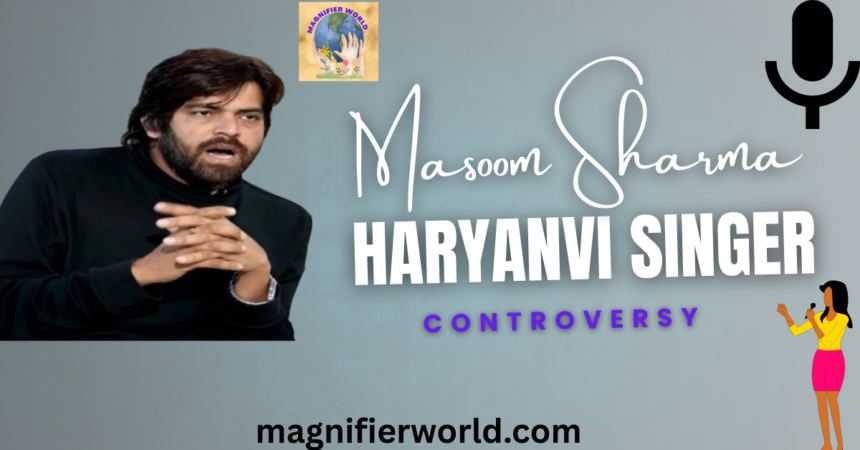Introduction
In the Haryanvi music scene, Masoom Sharma is well-known for his captivating songs plus folk-inspired sounds. The Masoom Sharma Haryanvi singer controversy has stirred debates across the music industry.
However, the lyrics wasn’t the only reason why he gained recent fame. Rather, Sharma is at the centre of a huge issue that includes accusations of violence, tunes that are prohibited, along with an awful occurrence that happened at a university concert.
That was once a successful music career is now marred by legal issues as well as public discord. Fans of Masoom Sharma, the popular Haryanvi singer, are divided over the recent controversy.
The “Masoom Sharma Haryanvi singer controversy” has sparked debates on anything between security to creative independence, resulting in ranging ranging from legal prohibitions to contentious performance performances. We’ll examine everything actually transpired and the reasons for the commotion.
Key Takeaways
- The state of Haryana prohibited several of Sharma’s tracks reportedly encouraging assault weapons.
- Man was charged with attacking a concertgoer in Gurgaon.
- Amidst a dispute at his examination at Punjab University, an undergraduate lost everything.
- Sharma says he lost about ₹5 crore in profits as a result of these problems.
- All of these occurrences brought up important issues concerning accountability, impact, and entertainment.
1. Why His Songs Got Banned
The Punjab state outlawed three of Masoom Sharma’s songs in that month 2024: “Khatoaa,” “60 Mukadme,” and “Tuition Badmashi Ka.” Authorities asserted that the songs might be harmful to adolescents because they glorified gangs civilisation, brutality, and gun use.
Masoom Sharma didn’t like the change.
He asserted that the prohibition were partisan in nature, claiming that a member of the press corps harboured resentment towards him. The recent controversy involving Haryanvi singer Masoom Sharma shocked his entire fan base.
However the institution providing that’s accurate, it sparked a contentious discussion.
Critics as well as enthusiasts disagreed. People who believed that artists should be allowed to make music thought prohibiting tunes seemed excessive.
2. The Gurugram Assault Incident
Another held that it is important to use caution when it comes to songs that influences young people’s behaviour, especially if the melodies encourage violence or criminality.
Regardless of your perspective, there’s a lot more certainly little doubt that this signalled the beginning of a significant decline in Sharma’s reputation.
While Masoom Sharma played at the Gymkhana Club in Gurugram, India, the situation deteriorated. A guy called Parvesh Baghoria reported Sharma before the investigating officer throughout the performance, claiming that Sharma had grabbed his collar and attacked himself within view of the audience.
The predicament worsened after a video of the event turned public. The Masoom Sharma controversy is now the biggest topic in the Haryanvi singer community.
Sharma swiftly retorted, however, that the individual hadn’t been a fan that guy tried to snap photos along with interfere with the performance as a member of the production crew.
Whatever the reality, there was a lot of pushback at the time. Sharma came under fire from many for losing his composure, particularly in such a public place. The state’s music ban fueled the Masoom Sharma Haryanvi singer controversy even further.
It also raised awareness of the expanding security problem at live performances, when both audience members and artists occasionally act inappropriately.
This viral incident wasn’t isolated; rather, it contributed to the expanding body of evidence suggesting Sharma was becoming into a contentious and erratic figure.
3. A Death at Panjab University
A Masoom Sharma performance at Punjab University may have been the most devastating event in this debate. Several student groups fought downstairs during his performance, and the altercation became fatal.
Three students were hurt, and one student, Aditya Thakur, died. The Haryanvi singer faced backlash after the Masoom Sharma controversy made headlines.
The campus was stunned by this tragic episode, which resulted in several convictions. To determine how such violence could break erupted at a gathering that was ostensibly an artistic performance, prosecutors opened an inquiry.
Even though Masoom Sharma was not actually involved in the altercation, the episode fuelled the flames. People started to wonder perhaps his shows encouraged dangerous situations.
In the middle of the controversy, Masoom Sharma remained calm as a respected Haryanvi singer. An impassioned outpouring of condemnation resulted from the loss of a young life during one of his performances.
It was an alarming reminder why security has to be improved at public meetings, notably when feelings are running ravenous and sizable crowds are gathered to see well-known acts.
4. Financial Fallout from the Controversy
In addition to harming Sharma’s image, such issues additionally caused him money. He claimed in a conversation that the YouTube deletion as well as ban of one of his songs, “Ek Khatoaa Jail Ke Bheetar,” cost him around ₹5 crore.
A financial setback on this nature might be disastrous for an individual who developed his profession on his own. Many people believe the Masoom Sharma Haryanvi singer controversy was blown out of proportion.
There were genuine repercussions, including decreased donations, cancelled events, and diminished viewers.
Concern began to spread among additional Haryanvi singers. Who may be the next to have their music removed from platforms due to contentious lines? That video clip reignited the Masoom Sharma Haryanvi singer controversy on social media.
Several started reanalysing their own lyrics, and some even went beyond as to edit their forthcoming compositions even erase their current ones.
5. The Bigger Picture: Music, Influence & Responsibility
There are several singers in Masoom Sharma’s narrative. It’s concerning the effect of sounds, the consequences of celebrity, and the accountability which accompanies power. No one expected a Haryanvi singer like Masoom Sharma to be involved in a serious controversy.
Some contend that sound is a reflection of culture, revolt, and real-life challenges. However, there is a risk that songs that romanticise bloodshed or firearms would transcend art and turn into a way of life.
Community is paying a lot more closer attention nowadays than ever before, as evidenced by the court battles and rallies that have been quite around Sharma.
The controversy surrounding Masoom Sharma, the beloved Haryanvi singer, continues to grow.
Artists are being held responsible by all means not only for their work but also for the way it influences public sentiment, especially in young people.
Conclusion
Not only is the Masoom Sharma incident a scandal, but it also serves as an image illuminating current economic along with cultural discussions. News channels covered the Masoom Sharma Haryanvi singer controversy extensively last week.
Sharma’s ascent as well as decline demonstrate how swiftly things can change in the world of cinema. You may be at the leading edge of the album charts for one minute, followed by you may be banned, the subject of government grievances, and the target of public indignation.
His narrative raises significant queries: If song praises brutality, must it be banned? Should artists be more selective about their work? The entire Haryanvi singer community rallied around Masoom Sharma after the controversy broke out.
Furthermore, who draws the boundaries?
It remains to be seen if Sharma will recover or if his contributions might become more controversially appreciated.
The music world was shaken by the Masoom Sharma controversy involving the Haryanvi singer. However, his predicament serves as an indicator for artists, supporters, and legislators to consider more carefully the concepts we spread, encourage, and commemorate.
FAQs
Q1: What led to the songs of Masoom Sharma being banned?
His music was outlawed for purportedly propagating gun ownership along with abuse, especially between young people.
Q2: How did his show in Gurgaon go?
Sharma says there was a mistake concerning a good teammate, but he was accused of attacking another person on court.










